| Construction Rating: | starstarstarstarstar |
| Flight Rating: | starstarstarstarstar |
| Overall Rating: | starstarstarstarstar |
| Length: | 77.70 inches |
| Manufacturer: | Public Missiles  |
 Brief:
Brief:
The PML Amraam 4 is a half-scale version of the AMRAAM/AIM-120 used by both the U.S. Navy and Air Force as a medium range air to air missile. The kit is semi-scale due to the fact it is 1/2" larger in diameter and 6" longer than a true 1/2 scale representation.
Components:
My kit was custom ordered from Magnum Rockets as a CPR3000 ready kit, which means the lower tube was pre-cut at the factory to incorporate the CPR3000 Dual Deployment option. Note this now: I HIGHLY recommend anyone building this kit to go the extra mile and purchase the CPR3000 option with the kit. The CPR3000 Dual Deployment System allows the use of a larger variety of motors that can reach some high altitudes while maintaining a closer recovery for the rocket. Please note that, with this kit, the CPR3000 cannot be added at a later date because of the way the A4 is constructed for single deploy.
Another tip; the kit also comes with PML's "Kwik Switch 2000", including a 54mm top threaded motor mount, which allows you to simply screw in supplied motor adapters for 38mm and 29mm. You should be able to request the kit with the LONGER motor mount tubes or can order the "Extended Kwik Switch". As the kit comes, it will not accept the 38/720-1080 motors or the 54/1706 Motor. The extended version includes longer motor mount tubes to incorporate the longer RMS Motors, however, I built mine with the standard tubes and now wish I had the longer ones installed. One final recommendation would be to upgrade your parachute size from the stock 54" to 60" to compensate for the extra weight of the CPR3000.
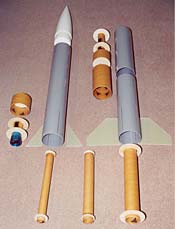 The kit came in a bag with the lower half tube pre-cut with the lower fin section at 16 1/2" in length, which is the only requirement for CPR conversion on this model. Also, included were the nosecone, upper tube pre-slotted for center fins, G-10 Fiberglass fins, bulkheads, pistons, couplers, 54" ripstop nylon parachute and all the hardware. This is a superb quality kit, using the best components commercially available. The body tubes were made of PML's "Quantum" tubing, approximately 1/16" thick plastic, somewhat flexible/forgiving and smooth with no spirals. A quality set of decals also came with the kit, along with an easy to follow instruction manual.
The kit came in a bag with the lower half tube pre-cut with the lower fin section at 16 1/2" in length, which is the only requirement for CPR conversion on this model. Also, included were the nosecone, upper tube pre-slotted for center fins, G-10 Fiberglass fins, bulkheads, pistons, couplers, 54" ripstop nylon parachute and all the hardware. This is a superb quality kit, using the best components commercially available. The body tubes were made of PML's "Quantum" tubing, approximately 1/16" thick plastic, somewhat flexible/forgiving and smooth with no spirals. A quality set of decals also came with the kit, along with an easy to follow instruction manual.
The CPR3000 came separately with the aluminum threaded CPR couplers, altimeter bay, dual pistons (this left me with an extra piston, which was used for other means during construction) shock cords, centering rings, 38mm Altimeter bay tubes, altimeter mounts, "O" rings, 6amp on-off switch for the altimeter and all associated hardware needed to incorporate it into the Amraam 4. The instruction manual was very good and step-by-step construction went very well.
Component Rating: 5 of 5
Construction:
Epoxy (15 minute) was used throughout the construction, which begins with the assembly of the Kwik-Switch 2000. The plastic threaded top caps are epoxied to each of the 54, 38 and 29mm tubes, then centering rings are glued to the lower section of tube for each of the 38mm and 29mm adapters. Sand these centering rings for a good fit into the 54mm motor mount, but don't over-sand as you want a smooth fit with no play. Glue a fillet on both sides of the ¼" ply centering rings.
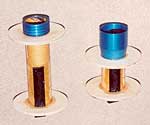 Once the motor mount and adapters are complete, you need to assemble the CPR3000 assemblies. Follow the instructions as you construct the upper and lower assemblies. Pay attention to the Blue Aluminum threaded adapters and install them as indicated. Also, note that the altimeter bay section is installed in the lower body tube and is longer than the other CPR assembly. Once you have glued the black shock/piston straps to the sides of each CPR assembly, GLAZE the top of each strap with epoxy for added strength. Finally, you glue the assemblies into each body tube. Follow the instructions here and it will go well. A quick note, I used 80 grit sandpaper on all parts of the plastic Quantum body tube for roughing up an area prior to gluing. It has more bite than the suggested 120 grit and cuts deeper grooves for a good glue joint. After the upper CPR assembly is glued in the tube, clean out the upper fin slots of any epoxy before it sets so the upper fins will fit flush later.
Once the motor mount and adapters are complete, you need to assemble the CPR3000 assemblies. Follow the instructions as you construct the upper and lower assemblies. Pay attention to the Blue Aluminum threaded adapters and install them as indicated. Also, note that the altimeter bay section is installed in the lower body tube and is longer than the other CPR assembly. Once you have glued the black shock/piston straps to the sides of each CPR assembly, GLAZE the top of each strap with epoxy for added strength. Finally, you glue the assemblies into each body tube. Follow the instructions here and it will go well. A quick note, I used 80 grit sandpaper on all parts of the plastic Quantum body tube for roughing up an area prior to gluing. It has more bite than the suggested 120 grit and cuts deeper grooves for a good glue joint. After the upper CPR assembly is glued in the tube, clean out the upper fin slots of any epoxy before it sets so the upper fins will fit flush later.
Once the CPR 3000 is installed in both tubes, you will see why a rocket already built cannot be converted to the dual deploy system. For a NON-CPR kit they would have you glue in a 12" long body tube coupler where the upper CPR unit resides, then glue the upper fins to the coupler. For this reason, you need to decide on the CPR system PRIOR to construction. I wound up using the unused 12" coupler as a "holder" while painting the body tubes.
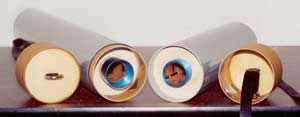
Before you assemble the pistons, take the extra piston tube from the kit bag and glue it inside the upper body tube, flush with the top plywood centering ring of the upper CPR assembly. I did this for two reasons; it gives you some surface area to glue the center fins on and it prevents the upper piston from getting stuck at the fin area during flight/prep. Once you glue this extra piston in, epoxy the upper piston assembly to the black shock/piston cord. I also used epoxy and glazed the inner and outer wooden surfaces of each piston and the bulkhead once assembled. This makes them stronger and waterproof/powder proof so they can easily be cleaned up at the field.
Next, you assemble the lower body tube. Sand the entire outer surface of the 54mm tube and the inner surface of the body tube at the fin area with 80 grit sandpaper. Glue the 54mm Motor mount in, but do not use the "scotch tape" method on the rear centering ring as they suggest. Trust me, the tape just breaks off. I installed the motor mount and the rear centering ring without tape, then, once the glue was set at the top, I used a metal ruler through the fin slot to push the lower centering ring back out. Much easier to do than tape.
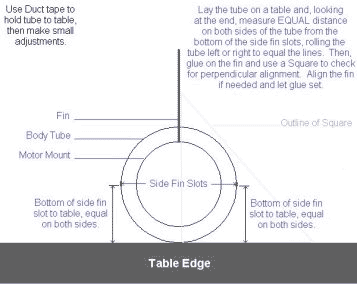 Lower fins are glued on next; I put a small amount of epoxy on the edge of a fin, then inserted it through the fin slot and allowed its own weight to hold it down on the motor tube. I did not use a jig, but rather used the method shown for gluing all fins. Once all four fins were glued, I cut 1 1/2" wide strips of 2oz fiberglass cloth to the length of each fin, then glassed the space from the motor mount to the fin and inner body tube. Soaking the cloth in epoxy then folding it around a 1/2" wide stick allowed me to insert it into the tube, then the stick was used to make sure the cloth was pressed down on all surfaces. This added strength inside the body tube like you cannot believe, as I have had these fins break clean off without glassing on other PML kits. I now glass all my fins and it pays off!!!
Lower fins are glued on next; I put a small amount of epoxy on the edge of a fin, then inserted it through the fin slot and allowed its own weight to hold it down on the motor tube. I did not use a jig, but rather used the method shown for gluing all fins. Once all four fins were glued, I cut 1 1/2" wide strips of 2oz fiberglass cloth to the length of each fin, then glassed the space from the motor mount to the fin and inner body tube. Soaking the cloth in epoxy then folding it around a 1/2" wide stick allowed me to insert it into the tube, then the stick was used to make sure the cloth was pressed down on all surfaces. This added strength inside the body tube like you cannot believe, as I have had these fins break clean off without glassing on other PML kits. I now glass all my fins and it pays off!!!
Once the fins are glued on, you glue the bulkhead assembly to the top of the fin tube. CAUTION!!! I found a problem here with the design of the kit, so pay attention. The instructions tell you to glue the bulkhead/coupler into the body tube flush against the motor centering ring and leave half of it sticking out. Well, it leaves a bit more than half sticking out, about 4 1/2" to be exact. THIS IS A BIG PROBLEM. When the lower CPR body tube is slid over this bulkhead, there is less than 1 1/2" of space between the top of the bulkhead and the face of the lower piston. There is NO WAY you can insert a shock cord and drogue chute in this small space. I worked with the PML techs and suggested they shorten the coupler tube so that only 3 1/2" are sticking out of the lower fin body tube. They are currently in the process of applying this modification as an addendum to ALL Amraam 4 CPR only kits so you may see a fix in your kit by the time this is published.
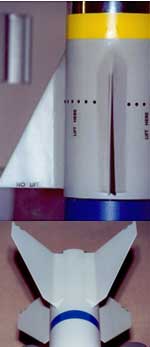 Next step is to glue on the upper fins, which went well. Once all 8 fins were glued, I fiberglassed all of them on using 1 1/2 oz cloth and 15 minute epoxy. I ran the cloth from about 2" up one fin, down and across the body tube and up the other fin about 2". FYI: using this method I have NEVER broken a fin out of the slot, as had happened before on PML kits as small as 2" without fiberglassing. If you fly on any kind of hard surface or in the winter, fiberglass your rocket's fins.
Next step is to glue on the upper fins, which went well. Once all 8 fins were glued, I fiberglassed all of them on using 1 1/2 oz cloth and 15 minute epoxy. I ran the cloth from about 2" up one fin, down and across the body tube and up the other fin about 2". FYI: using this method I have NEVER broken a fin out of the slot, as had happened before on PML kits as small as 2" without fiberglassing. If you fly on any kind of hard surface or in the winter, fiberglass your rocket's fins.
Launch lug placement instructions are supplied in the kit, but use the locations provided in the CPR kit when gluing them on if you use CPR. My upper lug was flush with the top of the lower CPR tube per PML's recommendation. Make sure you install the altimeter and 4" O-ring, then tighten the tube and align the upper fins to the lower fins. Now you can glue on the lugs. I used a 3' piece of 1/2 " steel rod to align the lugs while the glue set. Finally, I applied fillets to each fin side and the sides of each launch lug. I turned the rocket so fins were at a 45 degree angle, used masking tape to create a "dam" on the top and bottom of each fin, then mixed 15 minute epoxy with some milled fiberglass from Bob Violett Models and poured it in the area. Heating the epoxy in the microwave so it is hot and runs like water makes it easier to pour in the area and leaves nearly a sanding free fillet. See the pictures for fillets on my rocket.
Construction Rating: 5 out of 5
Finishing:
White Krylon primer was applied prior to the first sanding and I used 100 grit to cut away any excess epoxy resin left from the fiberglassing and to blend in the cloth seams. Use an electric sander in the glassed area, which cuts through the epoxy nicely and blends glass seams well . A few more coats of primer were added, then I wet sanded with 220 grit. Finally, two more coats of primer were added and I finished it up by wet sanding with 400 grit. Once primer was finished, the Quantum body tubes and fins paint like a dream!
Light Gray Glossy Krylon paint was used on the body tubes and fins, which left a nice and smooth surface to apply decals. The nosecone was done in Krylon Flat White. I used Testors Gloss Navy Blue, Gold and Yellow for the 1" stripes and used a piece of Monokote self stick Chrome for the silver section. Once all decals were applied, I used TopFlite Clear Dullcoat for the flat military look. Do not use Testors Dullcoat; it leaves dirt and fingerprints like crazy which cannot be cleaned. The TopFlite can be found at any R/C hobby shop and is waterproof, alcohol proof and cleans easily. When applying the Dullcoat, you must use light "dusting" layers; the Testors stripes you painted will orange peel if you put it on too thick. I had to re-do my yellow stripe for this reason, learned my lesson, and the rest of the rocket came out great. Just use light coats and it will Dullcoat fine.
Finally, shock cords and parachutes were attached per the instructions. Don't forget to tack glue your knots with a drop of epoxy. You also get two really cool 2" steel links with the CPR kit; a very nice touch for mounting the parachutes.
Finish Rating: 5 of 5
 Flight:
Flight:
My rocket weighed in heavy; 7lbs 9oz when comparing to the PML charts of 5lbs. I can account for the extra weight though, since I had an extra pound or more for the CPR and another pound plus due to glassing and fillets.
 I used an Altec RAS-2 Recording Altimeter with dual deploy for the electronics. Altec has a pretty much flawless reputation and I wanted something that would record all my flight data, so this was the one for me. The rocket was easy to prep and the CPR3000 is a dream to load. Daveyfire 28BR Electric matches were used for the CPR charges and I used .7grams of FFFFg black powder in the rear section for drogue chute deployment and 1 gram in the forward section for the main chute. My good friend Ken Parker designed a scooper for the powder charges later on, using empty brass from shell casings or you can use plugged brass tubing. We measured in the powder, marked the side of the case, dumped out the powder and cut it to length for a perfect sized scooper. My first flight was to be on a J275W, so I prepped one more Daveyfire with about 3" of Red Thermalite taped to the match head for the motor igniter.
I used an Altec RAS-2 Recording Altimeter with dual deploy for the electronics. Altec has a pretty much flawless reputation and I wanted something that would record all my flight data, so this was the one for me. The rocket was easy to prep and the CPR3000 is a dream to load. Daveyfire 28BR Electric matches were used for the CPR charges and I used .7grams of FFFFg black powder in the rear section for drogue chute deployment and 1 gram in the forward section for the main chute. My good friend Ken Parker designed a scooper for the powder charges later on, using empty brass from shell casings or you can use plugged brass tubing. We measured in the powder, marked the side of the case, dumped out the powder and cut it to length for a perfect sized scooper. My first flight was to be on a J275W, so I prepped one more Daveyfire with about 3" of Red Thermalite taped to the match head for the motor igniter.
This was my Tripoli Level 2 Certification flight at Whitakers, NC, so the altimeter was powered on and inserted into it's bay at the launch pad, CPR halves were screwed together, fins were aligned and the rocket was placed on the launch rod. Countdown was on and, when it lit, WOW, what a sight!!! You HAVE to experience it, the rocket left the pad like it was on rails, straight up, yellow orange flame spewing out of the bottom with an ECHO of the motor's sound literally ringing through the air, followed by a thick trail of white smoke.
Recovery:
Drogue chute separated right at apogee and the free fall was on. I set the altimeter to blow the main chute out at 750'. It worked like a charm and the cheers were there when the big 60" chute ballooned out and landed the rocket safely, WITHOUT a SCRATCH! Moreover, I received my Level 2 certification. Thanks to the Prefects, Ken Allen of Performance Hobbies and many supporting onlookers of Whitakers NC for making it a day to remember! In all my hobbies, rocketeers have been the BEST group of people I have ever met!!!
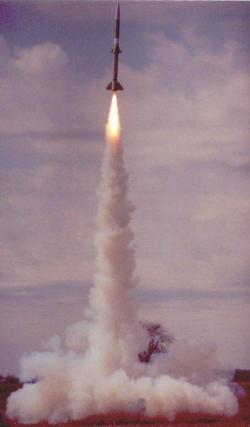 I launched one more J275W that evening to wrap up the last flight of the weekend and achieved success once more, with an added bonus. The darker skies helped the fire trail leave a "star" shape in the video, which really looks slick on film. Another safe landing convinced me that the extra effort during construction paid off. Finally, flight data was downloaded to my laptop; I achieved an altitude of 3023', pulled 7.2 G's, hit Mach .46 and the graphs showed each deployment charge as they fired... I really like that Altec altimeter! Total flight to landing was 88 seconds with the CPR; it would have been minutes with a non-CPR kit. Decent with the 60" (yes, I upgraded) parachute was around 18-20 feet per second, so the choice to use a larger chute paid off. The J275W is a perfect choice for this model; I do want to try a few others though and will report on them in the Flight Log section. Only minor problem I encountered was the paint on the bottom of my rocket was a bit scorched from the blast. I had it too close to the deflector, so this fault was entirely all mine.
I launched one more J275W that evening to wrap up the last flight of the weekend and achieved success once more, with an added bonus. The darker skies helped the fire trail leave a "star" shape in the video, which really looks slick on film. Another safe landing convinced me that the extra effort during construction paid off. Finally, flight data was downloaded to my laptop; I achieved an altitude of 3023', pulled 7.2 G's, hit Mach .46 and the graphs showed each deployment charge as they fired... I really like that Altec altimeter! Total flight to landing was 88 seconds with the CPR; it would have been minutes with a non-CPR kit. Decent with the 60" (yes, I upgraded) parachute was around 18-20 feet per second, so the choice to use a larger chute paid off. The J275W is a perfect choice for this model; I do want to try a few others though and will report on them in the Flight Log section. Only minor problem I encountered was the paint on the bottom of my rocket was a bit scorched from the blast. I had it too close to the deflector, so this fault was entirely all mine.
Flight Rating: 5 out of 5
Summary:
The PML Amraam 4 is a thing of beauty once assembled. All eyes turn on you and those not looking soon jump out of their seats when those BIG HP motors ignite! I am very pleased with this kit and look forward to many launches with it in the future. The only downside was the problem with the lower coupler being too long, which I found out about AFTER assembly. PML should now have this corrected in the documentation though, so future builders should be ok. Also, make sure you take care when aligning the launch lugs; once they are on, it's tough to re-position them. Finally, USE the CPR3000, fiberglass your fins and upgrade to a bigger parachute; you will regret it if you don't! In summary, this kit rocks and I look forward to many more purchases from PML, as their quality and Tech Service is excellent, bar none!
Overall Rating: 5 out of 5
 |
 |
Flights
 |
 |
J.C. (July 1, 2001)
D.W.V. (March 1, 2002)
L.V. (November 24, 2002)
Sponsored Ads
 |
 |












S.M. (May 1, 2001)